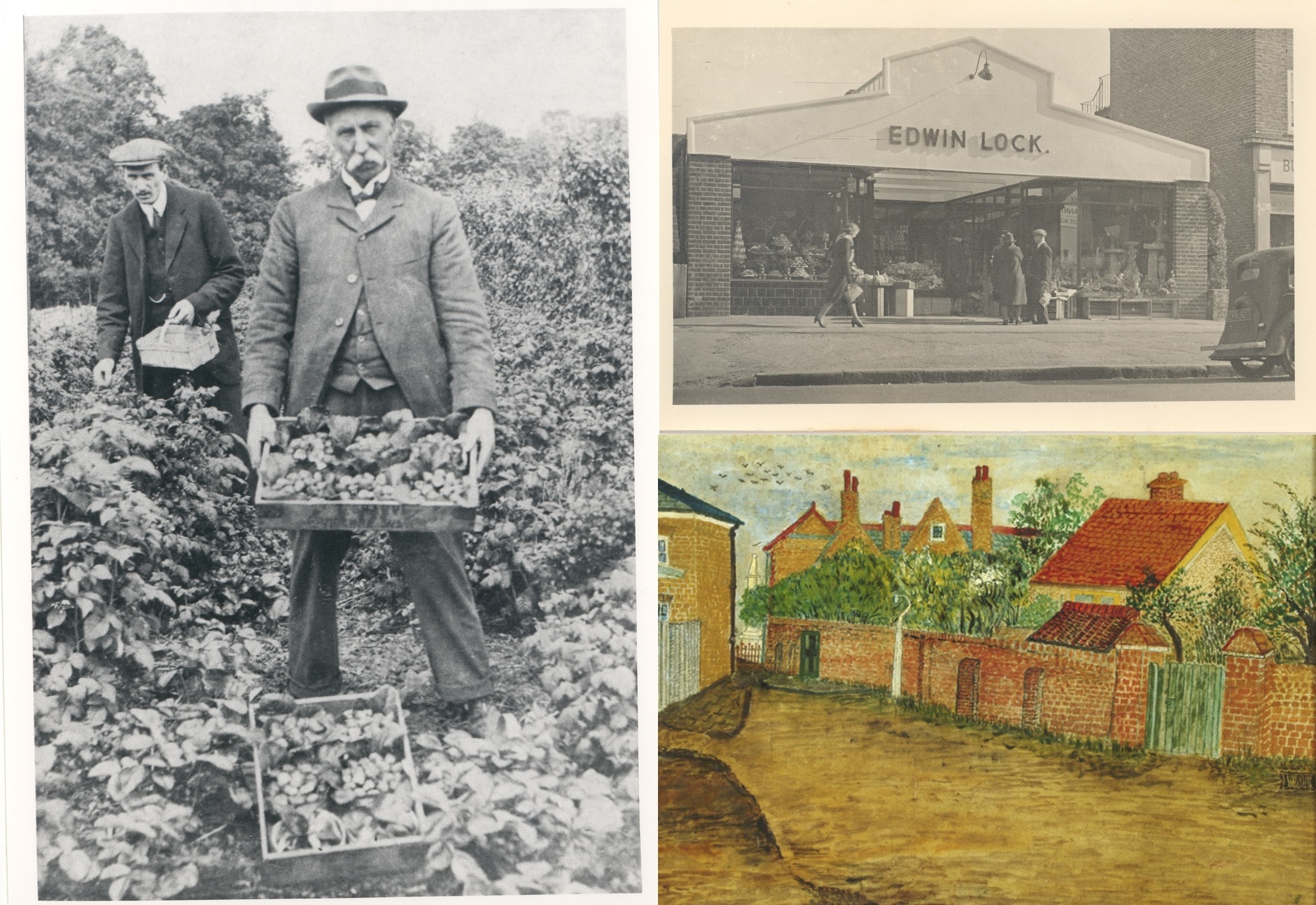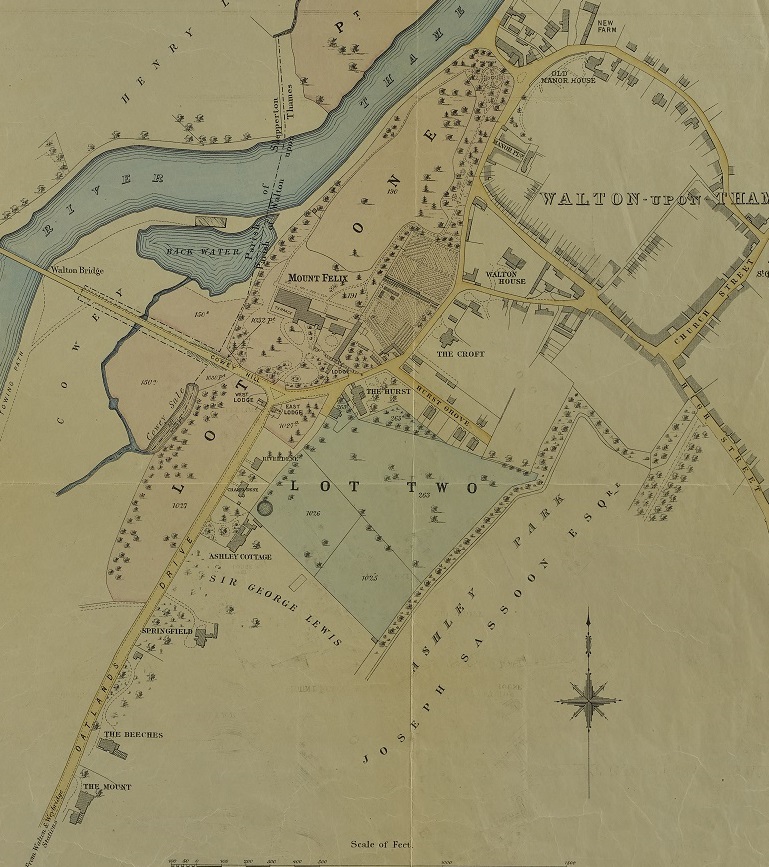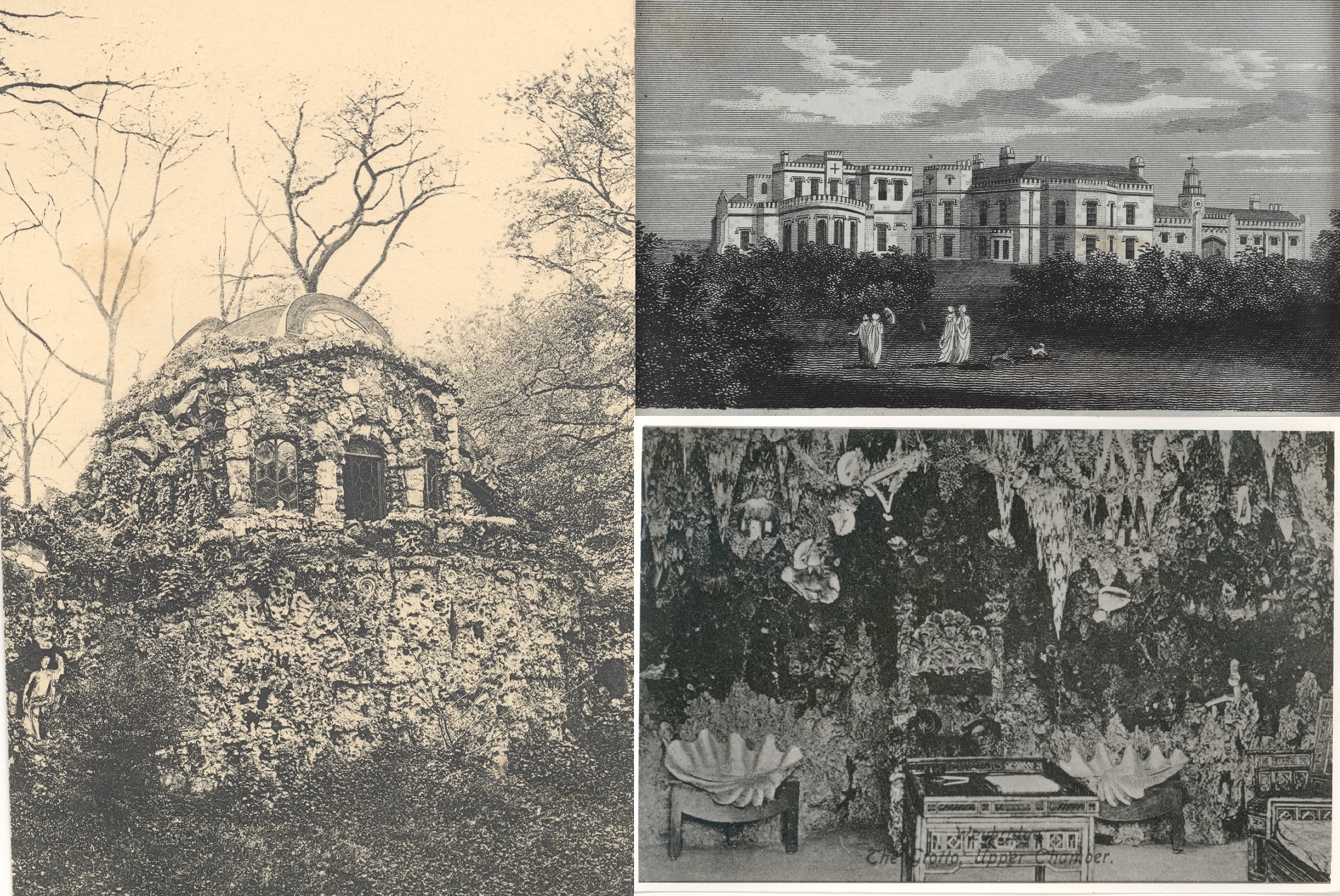Explore the latest news and find out what's on this month
Explore our learning offer for schools, families and community groups
Uncover the rich history of Elmbridge with our latest online exhibitions
Want to discover more about your local area?
Explore the latest news and find out what's on this month
Explore our learning offer for schools, families and community groups
Uncover the rich history of Elmbridge with our latest online exhibitions
Want to discover more about your local area?
Family-run businesses are scarcer than they used to be – but looking back at the last century there were plenty of names to recognize on your local high street. Here are a few that you should know!
 Clockwise: Edwin Lock with his father Albert, circa 1908; Edwin's shop front, circa 1950's; Edwin's painting of Springfield Lane, Weybridge.
Clockwise: Edwin Lock with his father Albert, circa 1908; Edwin's shop front, circa 1950's; Edwin's painting of Springfield Lane, Weybridge.
Edwin’s knowledge of fresh produce began when working for his father at a market garden in Shepperton. Before opening the shop, it was Edwin’s job to deliver vegetables to customers by carrying them in the sidecar of his motorbike. His father’s shop opened in 1908 but it was in 1931 that Edwin unveiled the shop he designed and built for himself. A man with a creative flair, Edwin won awards for his beautiful window displays and would later turn his hand to painting the streets of Weybridge he knew so well.
Learn more about Edwin in our Historic High Streets Exhibition Colour photograph of Mr C. Hibbert Senior (Centre) with Mr & Mrs Hyatt (Mr Hyatt former Vicar at Claygate 1978-1989) outside Hibbert's Greengrocers, The Green, Claygate, Winter 1995.
Colour photograph of Mr C. Hibbert Senior (Centre) with Mr & Mrs Hyatt (Mr Hyatt former Vicar at Claygate 1978-1989) outside Hibbert's Greengrocers, The Green, Claygate, Winter 1995.
Charles took over the family business from his father, Henry Hibbert, in 1967 and was known in the village for lending an ear to his customers. A fun-loving and friendly character, Hibbert would make characters out of potatoes for the children that came into his shop. Outside running the shop, he kept himself busy entering flower shows and winning the home-made jam competition with the Hibbert’s secret family recipe. A mainstay of the high street for so many years, the Hibberts extensively photographed the way Elmbridge changed around them and many landmark events in Claygate’s history. Take a moment to browse these photographs below!
Learn more about the history of Elmbridge's high streets here! Henry Hibbert (b.1884, d.1975) and grandson, Charles Hibbert, outside Hibbert's greengrocers, Claygate, during the coronation of Queen Elizabeth II, June 1953
Henry Hibbert (b.1884, d.1975) and grandson, Charles Hibbert, outside Hibbert's greengrocers, Claygate, during the coronation of Queen Elizabeth II, June 1953
 No 206 Claygate bus, in flood water in Hampton Court Way, East Molesey, Sept. 1968.
No 206 Claygate bus, in flood water in Hampton Court Way, East Molesey, Sept. 1968.  Cranes lifting near the fly over bridge at Hampton Court Junction, 1969. Seen through Angel Road bridge.
Cranes lifting near the fly over bridge at Hampton Court Junction, 1969. Seen through Angel Road bridge.
 Royal train at Esher carrying newly wed Prince Charles and Princess Diana through Esher station on their honeymoon, July 1981.
Royal train at Esher carrying newly wed Prince Charles and Princess Diana through Esher station on their honeymoon, July 1981.  Salter's Garage, in Hare Lane, Claygate, being demolished in June 1988 (orig. est. 1903).
Salter's Garage, in Hare Lane, Claygate, being demolished in June 1988 (orig. est. 1903).
 The Hare and Hounds Public House, Claygate, in the snow, 1991.
The Hare and Hounds Public House, Claygate, in the snow, 1991.  Part of a colour plan of Mount Felix Estate, Walton, for sale in 1898. Depicts River Thames, Oatlands Drive and Ashley Park owned by Joseph Sassoon Esq.
Part of a colour plan of Mount Felix Estate, Walton, for sale in 1898. Depicts River Thames, Oatlands Drive and Ashley Park owned by Joseph Sassoon Esq.
Looking further back in Elmbridge’s history to the 19th century, our collections hold family albums that show a grander style of living and expensive – often eccentric – pastimes.
This plan from 1898 shows the land available in Elmbridge to those with the means to buy it and the areas around Walton-on-Thames and Weybridge where two of our families lived.
The land extending into the lower right hand corner is marked as Ashley Park under the ownership of Joseph Sassoon Esquire.
And tiny in comparison, down Oatlands Drive in the lower left corner is The Beeches. This grand house was lived in by Edgar and Sybil Bruce, their daughter Etonia, their servants, and various animals and pets.
 Edgar Bruce and Boodles the dog, on a picnic by the Thames
Edgar Bruce and Boodles the dog, on a picnic by the Thames
Edgar Bruce attended St. John’s School of Photography as a leisure-time student, learning with fellow wealthy amateurs how to produce their own photographs. His photographs show the family in their home, sitting in the greenhouse, relaxing by the Thames, and often playing with the family dogs.
Sybil also frequently got behind the camera to capture amusing moments like this one with Edgar and Boodles the dog.
Look below for more of the Bruce family’s life at the Beeches!
Search our collections here for more photographs from the Bruce family here!
Sassoon David Sassoon bought the Ashley Park Estate in the 1860s, not long after leaving British-controlled Bombay in India and moving his family to London in 1858. He lived there with his wife Fahra, soon anglicised to Flora, and their four children.
The Sassoons were part of a very wealthy trading family and their eldest son Joseph Sassoon was to be married into an equally prestigious family. Flora took a leading role in arranging his pairing with Louise Gunzburg of Bavaria and their marriage took place in St Petersburg in 1884. With other marriage connections to the Rothschilds, it is not hard to understand why the rich Sassoons with their roots in Baghdad and Bombay were known as ‘the Rothschilds of the East’.
 The seven children of Joseph and Louise Sassoon photographed outside Ashley Park c. 1897. They are (left-right) Mozelle, Missy, Freddy, Arthur, Totts, Teddy and David.
The seven children of Joseph and Louise Sassoon photographed outside Ashley Park c. 1897. They are (left-right) Mozelle, Missy, Freddy, Arthur, Totts, Teddy and David.
Joseph and Louise would bring up seven children at Ashley Park.
Looking at this photograph of the Sassoon children, it is hard to imagine that all five of the Sassoon boys would do military service during the First World War.
At home, the grounds of Ashley Park were opened to the military for training and in 1916 the grounds were named as the assembly point for Walton residents in the event of the German invasion reaching England.
Learn more about the Sassoons and their connections to Empire here Apps Court with two members of the Gill family standing to the left of the house, in front of the fence dividing the garden from the parkland.
Apps Court with two members of the Gill family standing to the left of the house, in front of the fence dividing the garden from the parkland.
Robert Gill was a railway engineer and successful businessman involved in opening in the Manchester and Leeds Railway in 1842. He was also invested in the ambitious project of purchasing and moving the Crystal Palace from the Great Exhibition in Hyde Park to its permanent home in South London.
Using the newfound wealth from these projects, Gill moved his family to the grand, old mansion of Apps Court in 1855. Gill and his wife Fanny lived there with their children, their four girls being well-educated and invested in the work of female authors of the time. A novel by George Eliot gifted from Fanny to her eldest daughter Frederica survives in Elmbridge Museum’s collection to this day!
See below some the photographic portraits collected by Frederica in the Gill family album.
Learn more about the Gills here! Carte de Visite of Robert Gill
Carte de Visite of Robert Gill
 Carte de viste of Mrs Fanny Susannah Gill
Carte de viste of Mrs Fanny Susannah Gill  Carte de Visite of Mary and Madeline Gill
Carte de Visite of Mary and Madeline Gill
 Carte de Visite of Friede Gill, aunt to the Gill children
Carte de Visite of Friede Gill, aunt to the Gill children  Carte de Visite of Robert John Seppings Gill, aged 4
Carte de Visite of Robert John Seppings Gill, aged 4
 Sepia photograph of Peter Geesing. Coachman, at Apps Court.
Sepia photograph of Peter Geesing. Coachman, at Apps Court. From sculptures and pottery to sketches in pen and ink, Elmbridge has been home to all sorts of people with an artistic flair. Read about a few of these below.
 Rosemary Wren (aged 7), Denise and Henry Wren in the studio at ''Potters Croft''. Denise is working at a pot on the wheel, with Rosemary and Henry looking on.
Rosemary Wren (aged 7), Denise and Henry Wren in the studio at ''Potters Croft''. Denise is working at a pot on the wheel, with Rosemary and Henry looking on.
The Wrens taught courses at the Pottery, encouraging their students to experiment with different designs, glazes, and firing techniques. Denise studied design at Kingston and later had her daughter Rosemary who would follow in her footsteps as a hands-on artist and sculptor. Surrounded by artistic expression, Rosemary grew up in a house designed and built by the Wrens. Mother and daughter produced their work out of Oxshott Pottery until 1978, although their styles were quite different.
Taught under Archibald Knox, Denise was introduced to the influences of the Arts and Crafts Movement and Art Nouveau. She was often drawn to traditional forms with beautifully refined ornamentation and shining glazes.
Rosemary, on the other hand, was informed by modern sculpture and took inspiration from animals and nature. Notable pieces in Elmbridge’s collection include her bird sculptures, full of life and character as their little eyes seem to peer back at you.
Learn more about Denise and Rosemary's work here!The stories of royalty living in Elmbridge span from the stuff of romantic novels to children's nursery rhymes. Scroll down to learn about the exiled French nobility that was brushing shoulders with the 'Grand Old Duke of York' in some very extraordinary historical anecdotes indeed!
 Black and white etching print of The Chapel of Borromeo, Weybridge, the burial place of Louis-Philippe and the Duchess of Orleans
Black and white etching print of The Chapel of Borromeo, Weybridge, the burial place of Louis-Philippe and the Duchess of Orleans
Elmbridge has an extraordinary history of exiled French royalty escaping to safety in the houses of English nobility. When King Louis-Philippe I was deposed in 1848, he and his family fled to England and took Claremont House as their new residence, lent to them by Queen Victoria.
When he died, Napoleon III refused Louis-Philippe a burial in the Orleans family’s mausoleum at Dreux in Normandy. This led to the former King of France and many of his family members being laid to rest in a vault in the Chapel of Borromeo, a Catholic chapel in Weybridge whose services they had frequently attended.
It would not be until 1876, that his grandson the Comte de Paris would manage the removal of the family coffins and send them over land and sea to their Normandy mausoleum.
 Black and white photograph of St. Nicholas' Church, Fitzgerald Headstone.
Black and white photograph of St. Nicholas' Church, Fitzgerald Headstone.
First buried in Paris, Lady Pamela Fitzgerald’s tombstone was smashed in the Siege of Paris in 1870 and her body reburied in the graveyard of St. Nicholas Church in Thames Ditton.
She was the illegitimate half-sister of Louis-Philippe I and a frequent attendee of the court of Louis XVI. At the onset of the revolution, her father the Duke of Orleans enthusiastically joined those rising against the King and she met her husband Lord Edward Fitzgerald when he too rushed to join the revolutionaries in Paris.
Lord Edward was an Irish patriot who had renounced his titles and later had warrants out for his arrest for supplying arms to insurrectionists. This left Pamela in a very vulnerable position, having moved with him to Ireland she found herself no longer welcome there or in England. Forced to return to France, Pamela left two of her young children behind in England to be brought up by family.
It was a strand of the Fitzgerald family living in Thames Ditton that ensured Pamela’s return to England when they learned of the damage to her grave in Montmartre. She now lies in this churchyard alongside her daughters Pamela and Lucy and their many descendants.
 Clockwise: Image of Oatlands from garden; Image of gaming room; Image of Oatlands Grotto.
Clockwise: Image of Oatlands from garden; Image of gaming room; Image of Oatlands Grotto.
Prince Frederick Augustus, Duke of York and Albany was the second son of King George III and is infamous for his military career and scandals. The ‘Grand Old Duke’ nursery rhyme references his role as commander-in-chief of the British Army between 1798 and 1809, during which time he led unsuccessful campaigns in the French Revolutionary and Napoleonic Wars.
Making a strategic match with Princess Frederica of Prussia, the couple married in 1794 and moved into the Oatlands Estate in Weybridge. The seat of a former palace of Henry VIII that was demolished during the Civil War, Oatlands House was built in the 1720s and was surrounded by landscaped grounds including an elaborate gothic grotto.
 Image of The Prince of Pleasure cartoon by George Cruikshank. Depicts the re-instatement of the Duke of York as commander of the British Army in 1811.
Image of The Prince of Pleasure cartoon by George Cruikshank. Depicts the re-instatement of the Duke of York as commander of the British Army in 1811.
Covering the interior walls with shells and crystals, the grotto even had its own gambling room – not a surprising addition when you consider the Duke being dubbed ‘The Prince of Pleasure’ by the famous satirist George Cruikshank.
The Duke famously kept his mistress Mary Ann Clark close to Oatlands at Columb’s House, Weybridge. The details of their relationship become the focus of public scrutiny in 1809 when the Duke was dismissed from the military for promoting officers from whom Clarke had taken bribes.
Cruikshank’s cartoon marks the Duke’s reinstatement as commander a mere two years later, shown riding gleefully into the War Office while the Prince Regent welcomes him in.
In an unhappy marriage and plagued by her husband’s scandal, the Duchess of York was devoted to her many pets including her favourite dog ‘Satan’ and a racehourse called ‘Eclipse’.
Read more about the Duchess of York's pets here